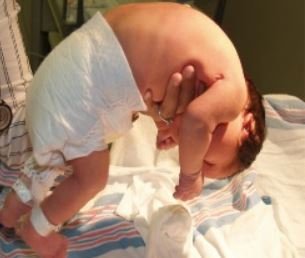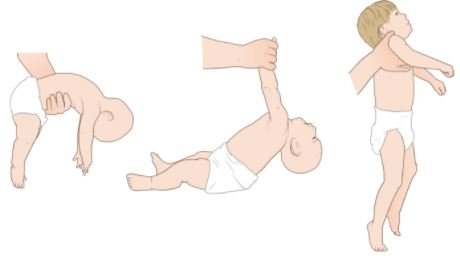What is Floppy Baby Syndrome?
Floppy Baby Syndrome is a condition occurs in infants due to neurological disorder related to a central nervous system and neuromuscular erroneous conditions. The involvement of central nervous system is higher in patients affected with Floppy Baby Syndrome. The resultant of the Floppy Baby Syndrome is reduced muscular tone. For that reason Floppy Baby Syndrome children unable to give prompt muscular response after receiving signals and also incapable of maintaining muscular contraction for a certain time, which is generally maintain by normal individuals1,2.

Symptoms
All the infants have Floppy Baby Syndrome at the time of birth or immediately after a certain period of childbirth. But the symptoms related to this syndrome improve with increasing age. But some of the parent’s complaint following symptoms even after a quite span of time of childbirth and that indicates the child has Floppy Baby Syndrome:

- Uncontrolled head
- Overall motor skill development is delayed, which causes delayed crawling, sitting, walking etc.
- Overall fine motor skill development is delayed, for example, difficulty in holding of crayon

However, it is noticed that Floppy Baby Syndrome can develop at any age. The overall symptoms related to the Floppy Baby Syndrome are as follows:
- Reduced muscular tone
- Reduced muscular strength
- Unable to extend limbs beyond the normal range
- Unable to suck or chew for extended period and that lead to feeding difficulty
- Compromised Reflex actions
- Hyper-flexibility
- Low breathing rate
- Difficulty in speech
- Decreased physical stamina
- Postural weakness 3,4

Causes
There are different reasons involve in the Floppy Baby Syndrome. The most common findings suggested the following reasons develop Floppy Baby Syndrome:

- Nervous system disorder: There are several reasons included to nervous system disorder:
- Meningitis or other traumatic brain infection can cause brain damage
- Internal brain hemorrhage during intrauterine development of the fetus
- Electrolytic imbalance during intrauterine development of the fetus
- Enzymatic abnormalities during intrauterine development of the fetus
- Adverse effect of drug
- Cerebral palsy
- Malformation of the brain that leads to defective central nervous system
- Genetic or chromosomal disorders
- Infections from birth Syndromes
- Traumatic injury to the spinal cord
- Muscular disorder like myopathy, muscular dystrophy
- Nervous system disorder like neuropathy and spinal muscular atrophy5
Diagnosis
The basic investigation after symptomatic analysis the following diagnostic tests may perform in a clinic
- Hematological Tests
- CK (Creatine kinase ) test: If test report showed that Increased level of CK in the blood, denoted muscle degeneration or muscular damage.
- CT scan (Computerized Tomography scan) of bones and muscles: This imaging tool assists to provide the cross-sectional images, which assist to the structural evaluation of the bone and muscle.
- MRI (Magnetic resonance imaging): a diagnostic procedure that uses a combination of large magnets, radio frequencies, and a computer to produce detailed images of organs and structures within the body.
- EMG (Electromyogram): This test is performed to evaluate the nerve and muscle functionality.
- EEG (Electroencephalogram): The electrical impulse generation and transmission inside the brain are evaluated through EEG.
Spinal tap
The pressure generates inside the spinal cord due to cerebral spinal fluid ( CSF ) accumulation is termed as a spinal tap.
Karyotype
This is the type of blood test performs for analyzing the chromosomal arrangement and that assists in evaluating genetic disorder.
Muscle biopsy
A small section is surgically extracted from the muscular tissue for examining and evaluating the sample under a microscope for detail analyzing the structural deformity. In Floppy Baby Syndrome, the muscle fibers diameter is smaller than the normal muscular fibers.1,5
Management
There is no specific treatment available for Floppy Baby Syndrome. The management of the Floppy Baby Syndrome is based on the supportive treatment.
Medical treatment often requires in Floppy Baby Syndrome due to some frequently occur symptoms like a joint dislocation.
The modern treatment method utilized for increasing the strength of the muscle
Sensory stimulation courses are applied after diagnosis of the underlying cause of the disease. In this medical course, multiple therapeutic approaches are applied including physical therapy, school-based program as early as the patient’s condition is detected.
There are some medical approaches available for treating Floppy Baby Syndrome:
A special training program provided by the developmental pediatrician for developing children’s social, intellectual and emotional development along with overall physical growth. In this training program, periodic developmental assessments are conducted for determining the progress of the delayed developmental symptoms.
Thorough neurological assessment and proper treatment is an important therapeutic approach to managing the body balancing difficulty, delay motor skill development, impaired reflex action overall cognitive developmental issues including speech, memory, language problem.
Assessment of chance of genetic involvement is also included in therapeutic approach. In this approach, The familial involvement is assessed with detail study of the chromosomal structure of the affected child.
Occupational therapy assists to give training for the development of physical and mental skill and that will help to perform the daily activity. The therapy gradually trains the affected children to improve coordination, fine motor skills, and self- help activities like wearing of dress, eating habit etc.
Physical therapy includes exercise, massage, heat and light therapy. This can help to improve muscular strength, muscle contraction period etc.
Speech and language training not only assist in improving communication skill but can improve oral problems including swallowing, feeding related problems arise due to Floppy Baby Syndrome.
Nutritional concerns
Weak sucking ability and difficulty in swallowing in Floppy Baby Syndrome often cause low body weight and overall health issues. Several artificial techniques like the application of specialized synthetic nipples, the surgical manipulating arrangement of mouth and jaw, gastrostomy tube insertion or tube feeding etc5.
Prognosis
The prognosis of the Floppy Baby Syndrome depends upon the underlying cause of the disease. Some individuals have Floppy Baby Syndrome symptoms for over a period of time and continue for life long. The affected individuals with mild Floppy Baby Syndrome may not have a developmental delay. The prognosis of the Floppy Baby Syndrome is improved with increasing of time and age. But children with severely affected with Floppy Baby Syndrome may need the assistance of walkers and wheelchairs and other supportive equipment5.
References
- Igarashi M. Floppy infant syndrome. J Clin Neuromuscul Dis. 2004 Dec;6(2):69-90. https://www.ncbi.nlm.nih.gov/pubmed/19078754
- Medical Definition of Floppy baby syndrome. Retrieve from http://www.medicinenet.com/script/main/art.asp?articlekey=3479
- Hypotonia. http://www.healthofchildren.com/G-H/Hypotonia.html
- George Krucik. What causes poor muscle tone? 10 possible conditions. http://www.healthline.com/symptom/poor-muscle-tone
- Dr. Ira Shah. FLOPPY CHILD. http://www.pediatriconcall.com/fordoctor/Diseases_a_z/article.aspx?artid=181

Floppy Baby syndrone and Pompa disease are the related ?